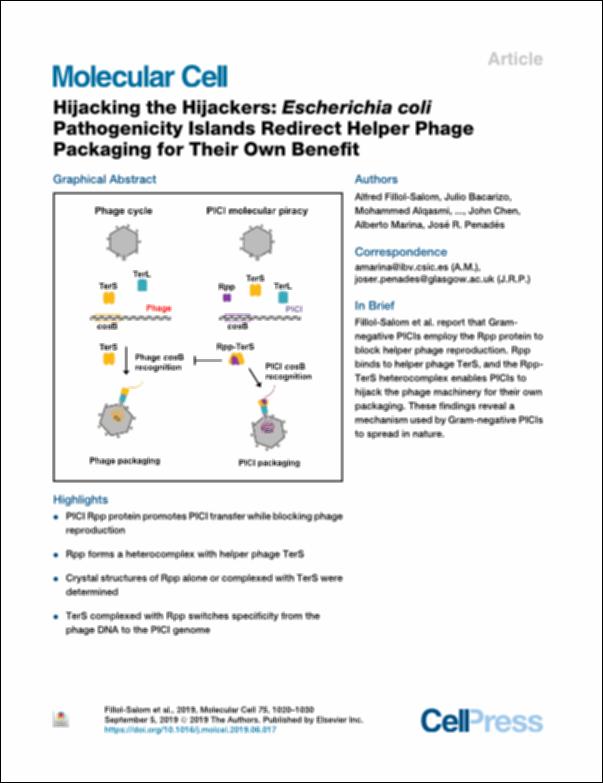Please use this identifier to cite or link to this item:
http://hdl.handle.net/10637/10873Hijacking the hijackers : "Escherichia coli" pathogenicity islands redirect helper phage packaging for their own benefit.
| Title: | Hijacking the hijackers : "Escherichia coli" pathogenicity islands redirect helper phage packaging for their own benefit. |
| Authors : | Fillol Salom, Alfred Bacarizo Roa, Julio Luis Alqasmi, Mohammed Ciges Tomás, J. Rafael Martínez Rubio, Roser Roszak, Aleksander W. |
| Keywords: | Bacteriófagos.; Bacteriophages.; Bacterias Gram-Negativas.; Gram-Negative Bacteria.; Bacterias patógenas.; Pathogenic bacteria.; Microorganismos patógenos.; Pathogenic microorganisms.; Bacterial genetic.; Genética bacteriana. |
| Publisher: | Elsevier |
| Citation: | Fillol-Salom, A., Bacarizo, J., Alqasmi, M., Ciges-Tomas, JR., Martínez-Rubio, R., Roszak, AW. et al. (2019). Hijacking the hijackers : "Escherichia coli" pathogenicity islands redirect helper phage packaging for their own benefit. Molecular Cell, vol. 75, n. 5, pp. 1020-1030, e4 p. (05 sep.). DOI: https://doi.org/10.1016/j.molcel.2019.06.017 |
| Abstract: | Phage-inducible chromosomal islands (PICIs) represent a novel and universal class of mobile genetic elements, which have broad impact on bacterial virulence. In spite of their relevance, how the Gramnegative PICIs hijack the phage machinery for their own specific packaging and how they block phage reproduction remains to be determined. Using genetic and structural analyses, we solve the mystery here by showing that the Gram-negative PICIs encode a protein that simultaneously performs these processes. This protein, which we have named Rpp (for redirecting phage packaging), interacts with the phage terminase small subunit, forming a heterocomplex. This complex is unable to recognize the phage DNA, blocking phage packaging, but specifically binds to the PICI genome, promoting PICI packaging. Our studies reveal the mechanism of action that allows PICI dissemination in nature, introducing a new paradigm in the understanding of the biology of pathogenicity islands and therefore of bacterial pathogen evolution. |
| Description: | Este es el artículo que se ha publicado de forma definitiva en: https://www.cell.com/action/showPdf?pii=S1097-2765%2819%2930473-3 En este artículo también participa Richard J. Cogdell, John Chen, Alberto Marina and Jose ́R. Penadés. |
| URI: | http://hdl.handle.net/10637/10873 |
| Rights : | http://creativecommons.org/licenses/by/4.0/deed.es |
| ISSN: | 1097-2765. 1097-4164 (Electrónico). |
| Issue Date: | 5-Sep-2019 |
| Center : | Universidad Cardenal Herrera-CEU |
| Appears in Collections: | Dpto. Ciencias Biomédicas |
Items in DSpace are protected by copyright, with all rights reserved, unless otherwise indicated.


